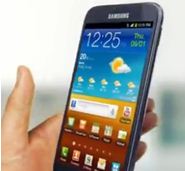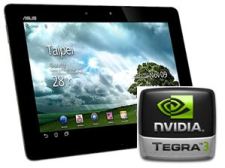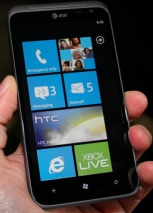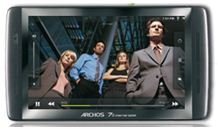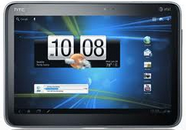Last update: February 3, 2013
This article has had over 16,000 views. Thanks for reading it.
Tablet Shopping Guide – No Opinions, Just the Facts
There have been lots of new tablets released since my last article, so I’ve decided to do an update. I started by evaluating all of the popular tablets, and then narrowed the list down to only eight finalists. Although there are some truly amazing 7” to 8.9” tablets out there, this article is only evaluating tablets that are 9.7” and larger. You can learn more about the new iPad mini and other smaller tablets here.
This time I’m trying a new approach. Instead of giving my opinion, I’m going to provide the facts, and let you decide for yourself. If you think I’ve missed anything, please let me know in the comments section. This is a “living” article that will be updated as I come across new information. Make sure to check back to see what has changed.
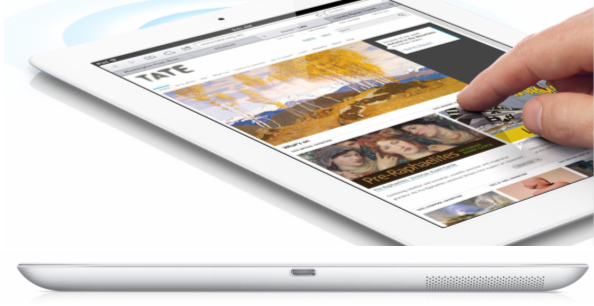
Apple just recently released the iPad 4 with a Lightning connector
Let’s start with the king of the tablets: The iPad. Apple has sold more tablets than any other manufacturer – by a long shoot. Just last week, Apple refreshed the “new iPad” by adding a Lightning connector, bumping up the speed on the processor and upgraded the front-facing camera. Let’s look at the strengths and weaknesses of the newest iPad:
Apple iPad 4
Strengths
Very good build-quality – All metal and glass construction
Fast performance – Beats the Nexus 10 on most benchmarks
Twice as fast as the iPad 3 in some benchmarks
More tablet-optimized apps than any other platform (275,000)
Very powerful battery (11,560 mAh) – Up to 10 hours battery life
Gets iOS updates on the first day they are available
Retina display (2nd highest resolution here 2048×1536)
One of the brightest displays
Boots in only 16 seconds
Excellent color accuracy
iOS apps are less likely to contain malware than Android apps
Dual-band 2.4GHz/5.0GHz Wi-Fi support
Optional 3G/4G support
Great selection of third-party accessories
12W AC adapter for slightly faster charging
Lightning connector is reversible so it can’t be inserted wrong
Has AirPlay support for wireless media beaming
Touchscreen can register 11 points at a time
Powerful headphone amp
1080p video with digital image-stabilization
Very good HTML5 performance
Best for portrait use
Smart cover automatically powers on the tablet when opened
Physical home button
Weaknesses
Heavier than all of the other tablets here except one (652g)
Thicker than all of the other tablets here except one (9.4mm)
Identical to the iPad 3 in most ways except processor, front cam and connector (case, display, etc.)
No memory expansion slot
Wi-Fi-only model doesn’t have an internal GPS
Use a proprietary connector so you can’t connect USB or HDMI cables directly
Lightning connector has no backward compatibility, so older accessories won’t work unless you buy an adapter
Much more difficult to repair than other tablets. Gets 2 out of 10 rating, which is horrible
Retina display has a big impact on battery life. One reviewer reports only 5.5 hrs video playback at full brightness
Gets badly beaten by the Nexus 10 on benchmarks like Geekbench (2480 vs. 1768)
Loads web pages slower than an iPad mini
3G/4G support costs $130 more (plus data charges and other monthly fees)
Single mono speaker (no front-facing stereo speakers)
Has half the memory of other tablets (1GB vs. 2GB)
Some visible light leakage the LCD display
No quad-core CPU like other tablets have
Doesn’t have NFC support
Gets very warm on the left-hand side after you’ve been using it for a while
Very reflective display
The iSight camera is only 5MP. Other tablets have 8MP and 13MP cameras
The iPad 4’s iSight camera lacks panorama, Photo Sphere and camera features found in other Android tablets
No infrared transmitter
Parental controls only work with iOS and even then have serious limitations
No camera flash – Low light photos are very noisy
The front camera records noisy 720p videos at a only 24fps in low light
No mouse support
Only has a 1.2MP front camera
Screen has a 4:3 aspect ratio, so 16:9 movies cannot be displayed full screen a must be letter-boxed
Has a 4-core GPU while other tablets have 8 or 12-cores
Worse battery life than all previous iPads
Screen is smaller than other tablets
No back button or menu button
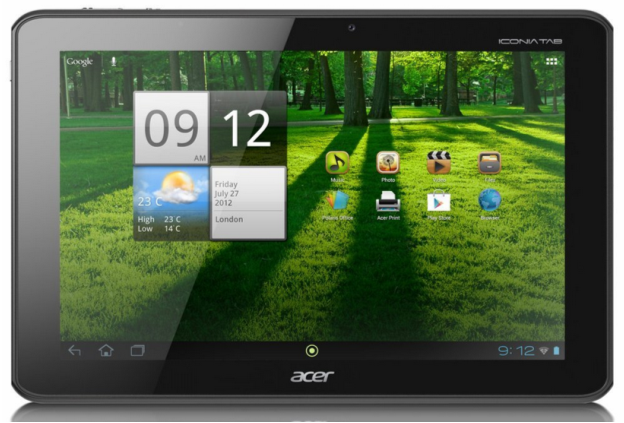
Acer makes several affordable 10.1″ quad-core tablets
Acer has three different 10.1” quad-core powered Android tablets with very similar specs: The Acer Iconia Tab A700 (which came out back in June) and the newer A700-10s32u and A700-10k32u tablets. The A700-10k32u tablets seems like a good value at only $399.99
Acer Iconia A Series
Strengths
Full HD 1920×1200 display (224 ppi)
Quad-core processor
A good value – starting at $399 with 32GB
Good build-quality
32GB storage (twice other tablets)
Includes a GPS
Stereo speakers
Has a microSD slot for memory expansion
Runs Android 4.1
HDMI connector for TV-out
Weaknesses
1GB of memory (Some others have 2GB)
Camera lacks an LED flash
No 3G/4G cellular option
Acer doesn’t specify a resolution for the front cam (normally that means it’s 0.3MP)
No NFC support
No 5GHz dual-band Wi-Fi support
Not as thin or light as some other tablets
No internal microphone
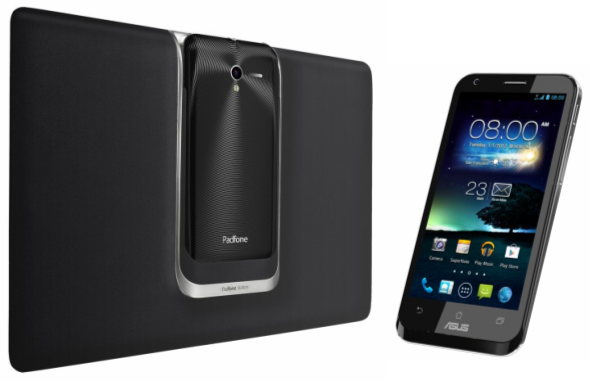
The ASUS PadFone 2 and dock are extremely innovative
The ASUS PadFone2 is one of the most innovative mobile devices available today. Its Android-powered smartphone has amazing specs and a 13MP camera. The phones slides into a dock to become a tablet.
Asus PadFone 2 with Dock
Strengths
Fast quad-core processor (1.5GHz)
Detachable phone works on its own, or docks in tablet
13-megapixel Sony BSI sensor plus f/2.4 five-element optics
Almost zero shutter lag, can also shoot up to 100 continuous shots at 6 fps
1080p at up to 30 fps
720p at up to 60 fps
Twice as much memory as most other tablets (2GB)
3G/4G support
NFC support
9.5 hour battery life
Capable of beaming to media AirPlay or DLNA devices when free 3rd-party apps are installed
Dual-band 2.4GHz/5.0GHz Wi-Fi support
Phone and dock weight less than the iPad 3 or iPad 4 (649g)
50GB of free ASUS web storage
Bluetooth 4.0
Weaknesses
No Android 4.1 support yet
No MicroSD slot
Not the highest resolution display (1280×800)
Single mono speaker
No physical home button
No infrared transmitter
No U.S. carriers are offering this phone yet
Limited stylus support (no pressure sensitivity, palm rejection, special features)
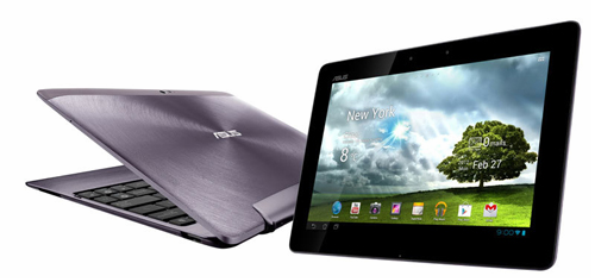
The Asus Transformer has one of the best keyboard docks available
The original ASUS Transformer Prime was the world’s first quad-core tablet. This Android-powered tablet been upgraded to a 1920p HD display and has an excellent optional keyboard dock. Some reviewers believe this is the best tablet available today.
Asus Transformer Pad Infinity TF700
Strengths
Fastest quad-core processor available today (1.6GHz)
Thinner than any of the other tablets here (8.5mm)
Twice the storage of most other tablets for $499 (32GB vs. 16GB)
True 1920p HD display (224ppi)
Fast graphics (12-core GPU)
Beats the Nexus 10 on most benchmarks
Android 4.1.1 update available (ships with 4.0.4)
Excellent keyboard dock with full-sized USB connector which offers 13-14 hours of battery life
8MP camera with f2.2 aperture
Can operate as a mobile Wi-Fi hotspot
Very good build-quality
Full size SD card slot
Light skin that doesn’t get in the way as much as TouchWiz
Bright display
Better black levels than the iPad 4 or Nexus 10
Higher contrast ratio than the iPad 4 or Nexus 10
Capable of beaming to media AirPlay or DLNA devices when free 3rd-party apps are installed
LED flash for camera
You can connect a standard mouse or external HD drive directly to the keyboard
microHDMI connector
Two microphones for stereo sound recording
Good selection of pre-loaded apps
1080p video capture
Gorilla glass 2 screen
Nexus devices do not come with locked or encrypted bootloaders. That means you are free to install customs ROMs and tailor your device however you like
Has an ASUS customized settings app
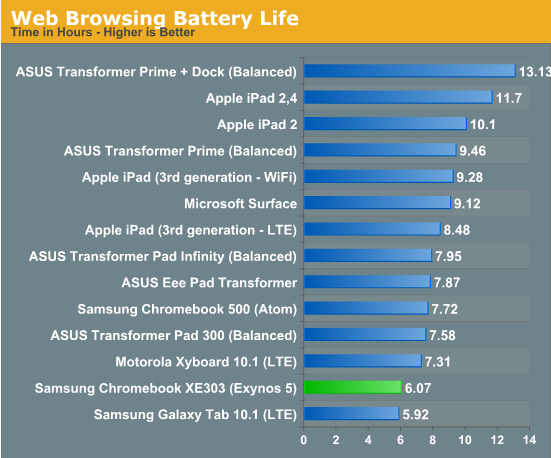
When docked, the battery life on the Transformer Prime is second to none
Weaknesses
Price starts at $599 but includes 32GB
Half the memory of other tablets (1GB vs. 2GB)
Images taken with camera are not the best
No NFC support
Slower Wi-Fi download speeds than the Nexus 10 and some other tablets
Not great low-light performance on camera
Single rear-facing speaker
Keyboard dock is $150 when purchased separately, but includes powerful battery
No dual-band 2.4GHz/5.0GHz Wi-Fi support
No optional 3G/4G support
Other tablets have better I/O performance
No infrared transmitter
No physical home button
Limited stylus support (no pressure sensitivity, palm rejection, special features)

Barnes’s and Noble’s Nook HD+ is the first 9.0″ tablet
Barnes’s and Noble’s Nook HD+ is the the world’s first 9.0″ tablet. It’s very light and costs less than any other tablet here (pricing starts at $269). This is a pure e-reader without extras like cameras, GPS and cellular capabilities.
Barnes and Noble’s Nook HD+
Strengths
The most affordable tablet here ($269 and up)
High-resolution HD display (1920×1280)
The lightest tablet here (only 515g)
Includes stereo speakers
High pixel densitiy screen (256ppi)
Expandable memory via Micro SD slot
Parental controls for a kid-safe experience
HDMI out via cable
A micro USB port rather than a proprietary connector
Weaknesses
Not yet shipping (pre-order available 11/8)
The thickest tablet here (11.4mm)
No front or rear cameras
Least powerful battery here (4000 mAh)
No 3G/4G data option
No NFC support
No Dual-band 5.0GHz Wi-Fi support
No GPS support
Lacks an ambient light sensor for automatic screen brightness adjustment
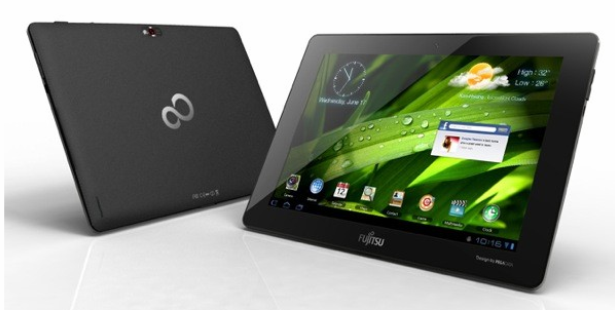
The Fujitsu Stylistic M532 is a durable business-ready tablet
The Fujitsu Stylistic M532 is a business-ready Android tablet. It has a fast quad-core processor and is thin, light and durable.
Fujitsu Stylistic M532
Strengths
Fast quad-core processor
The 2nd thinnest tablet tablet here (8.6mm)
Above-average durability
Designed for Business – Includes Absolute Computrace security
Has 32GB storage
Highest megapixel front camera available today in a tablet (2MP)
Has stereo speakers
8MP rear camera
Has 2.4GHz/5.0GHz dual-band Wi-Fi
micro USB port
GPS support
Stock Android – No bloatware
microSD card slot
Weaknesses
Display is good, but it’s 1280×800. The best tablets are 1920×1080 or higher
Only 149 pixels per inch on display (the best have 200-300ppi)
Inaccurate touch screen
No 3G/4G cellular data option
Expensive $549
30-pin proprietary connector
Runs Android 4.0.3
Only 1GB RAM (some others have 2GB)
No NFC support
No HDMI port (docking cradle ($69 direct) which allows HDMI out and USB inputs)
5 hour battery life – Lowest power battery here (3170 mAh)
Bluetooth 3.0
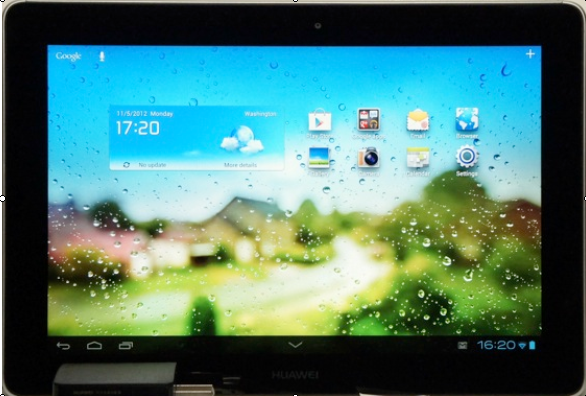
The Huawei MediaPad 10 is a 10 inch Android tablet with a quad-core CPU
The Huawei MediaPad 10 is a 10 inch Android tablet with a quad-core CPU and optional LTE support. Currently it’s only available in Europe.
Huawei MediaPad 10
Strengths
Quad-core CPU
1,920 x 1,200 IPS display
Optional LTE support
Very thin (8.8mm)
Attractive design
2GB memory
Good benchmark scores
Relatively light (580g)
Stereo speakers
Dolby 5.1 audio support
Strong audio output
microSD slot
Powerful amp for speakers
8-megapixel rear camera
Gorilla Glass screen
HDMI connector for TV-out
1080p video
Weaknesses
Pricing starts at 424 euros ($540 for 8GB Wi-Fi only)
Currently not available in the U.S.
Not great battery life (7+ hours)
Lacks microSD slot for storage expansion
Proprietary USB connector (no standard microUSB)
Heavy OS skin
No app drawer
No NFC support
Occasional delay when switching between open apps or launching apps
Sharp edges
Some issues with cameras
Rear-facing speakers
Highly-reflective screen
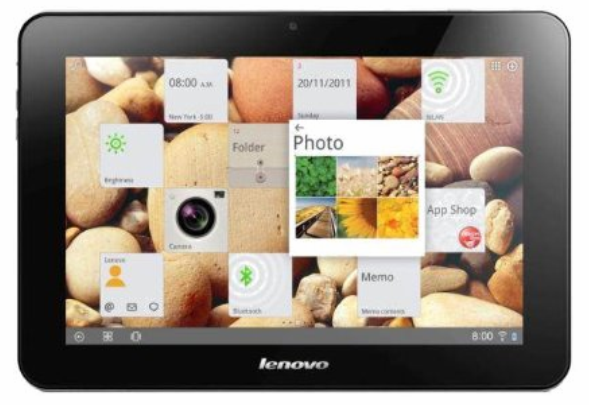
The Lenovo IdeaTab S2110 has a built-in FM radio
The IdeaTab S2110 is a 10/1″ Android-powered tablet from Lenovo with 3G connectivity and a built-in FM radio.
Lenovo IdeaTab S2110
Strengths
Very nice keyboard dock
Only tablet with a built-in FM radio
A good value. Pricing starts at $429
Bright display with 178° wide viewing angle
Very thin (8.69mm)
Fast dual-core processor (1.5GHz)
Dual speakers and SRS TruMedia audio enhancement
Optional 3G connectivity
10 hours battery life
Optional dock increases battery life to 16+ hours
Sturdy construction
Capable of beaming to media AirPlay or DLNA devices when free 3rd-party apps are installed
Micro-HDMI output
A micro USB port rather than a proprietary connector
5.0MP rear camera with autofocus and LED flash
1080p video recording
Bluetooth 4.0
Weaknesses
Lacks microSD slot for storage expansion
No optional 4G cellular
No NFC support
GPS is only available on 3G-enabled model
No 5GHz dual-band Wi-fi support
Matte finish attracts fingerprints
No infrared transmitter
No physical home button
Limited stylus support (no pressure sensitivity, palm rejection, special features)
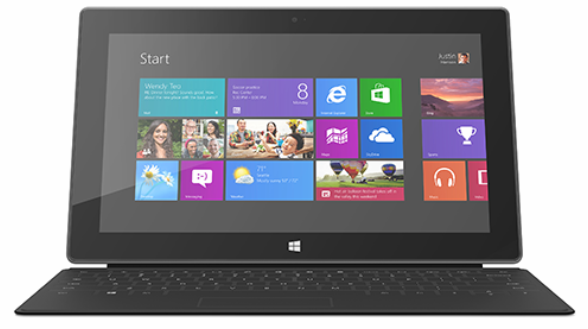
The Microsoft Surface RT is the only tablet which runs Office today
The Microsoft Surface RT is the most affordable Windows 8 tablet available today ($499). It runs Microsoft’s new Windows 8 Operating system and comes preloaded with a full-version of Microsoft Office.
Microsoft Surface RT
Strengths
Preloaded with Microsoft Office Home and Student 2013
Most affordable Windows 8 tablet ($499)
Best laptop replacement
Quad-core processor (1.3GHz)
Twice as much memory as iPad 4 and most other tablets (2GB)
Twice the storage as most other tablets (32GB vs. 16GB)
Split-screen multi-tasking feature
Multi-user support
Full-sized USB jack (instead of a proprietary connector)
More than twice as good as the iPad 3 in a JavaScript benchmark
Large screen 10.6”
Dual speakers
microSD memory slot
Has a sturdy built-in stand
2.4GHz/5.0GHz Wi-Fi support
Better keyboard support than some other tablets
The membrane keyboard doubles as a cover
Good HTML5 performance
16:9 screen
microHDMI jack
Gets OS updates on the first day they are available
Bluetooth 4.0
Weaknesses
Limited number of great third-party Windows 8 apps
Preloaded OS and apps consume 12 GB of space
Heaviest tablet here (676g)
Windows 8 requires some learning curve
Some reviewers say battery life is only 7-8 hours
No GPS support
Can’t run legacy Windows apps
Slower web page loading than other tablets
Outlook is not included with Office, so you have to use Mail and Calendar to sync up with Exchange
No NFC support
Only 1MP front and rear cameras with no auto-focus
No Dropbox (or other third-party Cloud-based storage apps) are available today
No optional 3G/4G support
Screen resolution is good, but not great (1,366×768)
Lower pixel density than other tablets here (148ppi)
Touchscreen can only register five points at a time
Magnetic cord is sometimes hard to attach
No camera flash
No infrared transmitter
Only 720p video support
Limited stylus support (no pressure sensitivity, palm rejection, special features)
Looking for a good collection of Microsoft Surface RT hardware reviews?.

The Nexus 10 tablet is the first 10″ tablet which runs Android 4.2
The Google Nexus 10 is an Android tablet which has a Samsung Exynos 5250 processor clocked at 1.7 GHz. It’s a dual-core Cortex-A15 chip that performs well in benchmark tests. Central to the speed of the Exynos 5 Dual is the ARM Mali-T604 graphics processor, which more than doubles the 3D performance of the already fast Samsung Galaxy S III’s chip. But the biggest standout in the Nexus 10 is its beautiful 2560×1600-pixel display.
Nexus 10
Strengths
World’s first tablet with a WQXGA 2560×1600-pixel display
Starts at only $399
First tablet with an Exynos 5 ARM Cortex-A15 processor that beats the Tegra 3 in benchmarks.
First and only tablet which runs Android 4.2. Will be the first to get Android 4.3
First tablet with multi-user support which allows you to set up a guest profile so someone can check their email but can’t update your Facebook status. Also allows different family members to have there own spaces and apps.
World’s highest resolution tablet display (300ppi) – Over 4 million pixels. Games like “Nova” look much sharper on the Nexus 10 than on the iPad 4
Pure Android OS (no skinning or bloatware)
Fastest processor speed available in a tablet today (1.7GHz). The Verge says: “apps launch a lot faster and multitasking is an absolute breeze — even with 20 apps open, nothing seemed to slow down.”
Fast quad-core Mali-T604 graphics processor – Engadget says it has the “smoothest graphics we’ve seen.”
Twice as much memory as most other tablets (2GB)
Comes with 5 books, 3 magazines, 10 songs, an HD movie and a TV show
Beats the iPad 4 on benchmarks like Geekbench (2480 vs. 1768)
Android 4.2’s voice input and speech-to-text entry are second to none
NFC support (Only mobile device with dual NFC sensors)
Gets all Android updates the first day they are available
The new Android 4.2 Gallery app has been improved so you can now tweak your photos like pro software.
Has Google Wallet preloaded. Allows you to purchase things with your tablet.
Boots in 19-24 seconds
Dual-band 2.4GHz/5.0GHz Wi-Fi support
Well-built and durable
Has MIMO WiFi and accelerated page-loading
Very good sounding stereo front-facing speakers
Rated “extremely repairable”
Capable of beaming media to AirPlay or DLNA devices when free 3rd-party apps are installed
Pleasant to hold. Doesn’t dig into your hand like the iPad 4
Has an RGB notification LED
Fast and smooth scrolling. The entire user interface runs at 60fps.
Android 4.2 has a new Swype-style keyboard that allows you to slide your finger around the keyboard to spell out words more quickly and accurately
Built-in barometer sensor improves GPS accuracy
Smart cover automatically powers on the tablet when opened
LED flash
No bloatware (pre-loaded apps which cannot be removed)
Quick settings can be accessed by pulling down on the top right portion of the screen
16:9 display
Good parental controls (when multiple profiles used)
Photos taken with its rear camera have better color accuracy, definition and less noise than the iPad 4’s camera
1080 video recording
A micro USB port rather than a proprietary connector
Gorilla Glass 2 screen
Built-in micro-HDMI port
Bluetooth 4.0
Weaknesses
16GB model is only available from the online Google Play store. 32GB model is available from Walmart, Staples, and Google Play
Many reviewers feel the Android ecosystem is lacking when it comes to good tablet apps
No microSD memory slot
Android 4.2 contains more bugs than earlier versions. Some were addressed in a 3.2.1 update, but others remain
No docks and limited other accessories are available yet
The included charger charges slowly, Consider buying Google’s magnetic pogo charger instead
No quad-core processor – Gets beat by the iPad 4, Transformer Prime and Galaxy Note 10.1 on most benchmarks
Battery life is acceptable, not great. One reviewer reports only 5 hours of video playback at full brightness
No 3G/4G support option today (some say it’s planned for the future)
Not as thin as the Asus Transformer Infinity (8.9mm)
Camera is only 5MP. Other tablets have 8MP and 13MP cameras.
Has a slightly larger bezel than other tablets (0.9″ Nexus 10 vs. 0.8″ iPad 4)
Like the iPad, it has some light leakage around the lower corners and sides of the LCD display
Wi-Fi signal strength issues
Lacks support of 802.11a
No infrared transmitter
Miracast not currently enabled
Its “smart cover” doesn’t stay closed very well
Limited stylus support (no pressure sensitivity, palm rejection, special features)
No physical home button
More Nexus issues listed under my first impressions article and a second article.
Update: The Nexus 10 went on sale on November 13th and the 32GB model sold out within two hours. Since then, Google has gotten more in.
What about the build-quality of the Nexus 10? Click here, and scroll down to the bottom of the article.
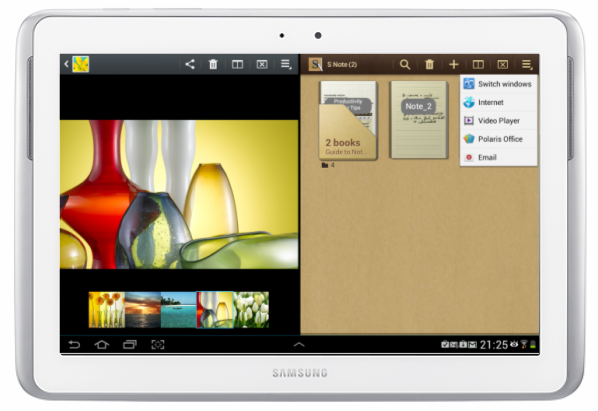
You can see the Split Screen feature here on the Galaxy Note 10.1
The Galaxy Note 10.1 is the only tablet here with full stylus support including pressure sensitivity. This Android-powered tablet also has the ability to split the screen in two and run two apps at once.
Samsung Galaxy Note 10.1
Strengths
Full stylus support (1,024 levels of pressure sensitivity, palm rejection, special features)
Fast quad-core processor (1.4GHz)
Excellent performance – Fast GPU – Beats the Nexus 10 on several benchmarks
Multi-view split-screen multi-tasking feature
Twice as much memory as most other tablets (2GB)
Very thin (8.9 mm)
microSD memory slot
Built-in infrared transmitter
9+ hours battery life (7000mAh)
Dual-band 2.4GHz/5.0GHz Wi-Fi support
Optional 3G/4G support
Good sounding stereo speakers
Capable of beaming media to AirPlay or DLNA devices when free 3rd-party apps are installed
Bluetooth 4.0
Includes quality stylus and storage space for it in the case
microHDMI jack
Weaknesses
Average-quality case
Average-quality 5MP camera
Not the highest resolution display (1280×800)
Uses TouchWiz skin
No NFC support
Preloaded with some Samsung apps which cannot be removed
No Android 4.1 support yet
Camera is only 5MP. Other tablets have 8MP and 13MP cameras.
No physical home button
Not scratch-resistant glass
Some have reported the default Clock, Media Hub, Game Hub and Music Hub widgets affect performance
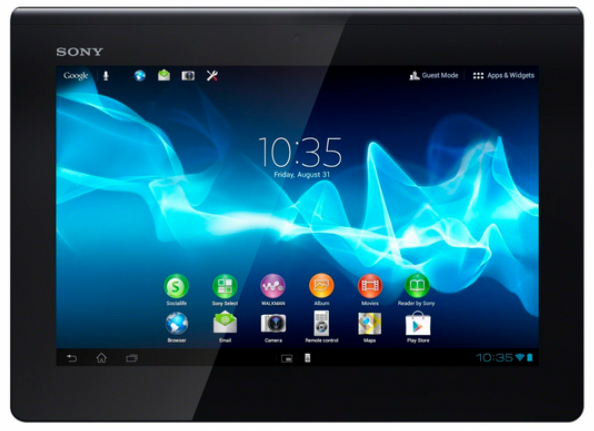
The Sony Xperia Tablet S is one of the thinnest tablets available
The Sony Experia is the lightest tablet here. This Android-powered tablet has a fast quad-core processor and built-in infrared transmitter.
Sony Xperia Tablet S
Strengths
Starts at only $399
Lightest tablet here (570g)
Quad-core processor (1.3GHz)
Built-in infrared transmitter with programmable macros
Very thin (8.6 mm)
NFC support
8MP camera
Scratch-resistant screen
Splash-proof (water resistant)
Dual-band 2.4GHz/5.0GHz Wi-Fi support
Stereo speakers
Capable of beaming media to AirPlay or DLNA devices when free 3rd-party apps are installed
Full-sized SD card
Full-sized USB port (instead of a proprietary connector)
Full-sized HDMI jack (instead of a proprietary connector)
Aluminum body
Weaknesses
Only 1GB RAM
Not the highest resolution screen (1280×800)
No optional 3G/4G support
No Android 4.1 support yet
Back is not flat. Has a bump near the top
Limited stylus support (no pressure sensitivity, palm rejection, special features)
No physical home button
No camera flash
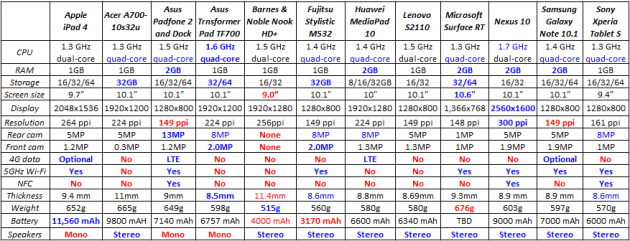
Areas of strength are shown in blue; Weakness is shown in red
That’s it! Now it’s up to you to select the best tablet based on your needs. Let me know which one you decide to buy and why.
Thanks for stopping by.
– Rick
P.S. Because I’m starting to get some stupid comments from Apple fan-boys, I’m going to give you a little background: Before anyone accuses me of being an Android fan-boy, you should know that almost all of this article was written on an iPad 3, which I like very much. I write very opinionated articles about all platforms. My previous post was about Windows 8 tablets. One of my most popular posts slams Samsung and Google about beaming. I was also an iPhone user for three years and think Apple TV is a great product. Some of the new Apple products look very appealing to me, but sadly the iPad 4 is not one of them. I’ve listed everything good and bad I can find about every tablet here and I’m continually updating this post as I find more stuff. Make sure to check back later to see how this article evolves. There are a few new tablets that have come out since I wrote this. Although I haven’t had time to add them yet, you can read about them in the Comments section of this article.
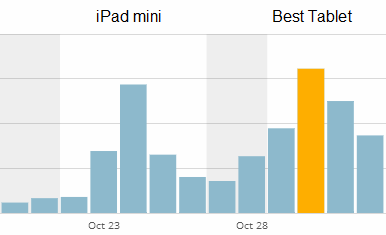
Thanks for making this my most popular post ever!
This post received more views on 10/30 than any other post I’ve even made. I never thought it was possible to get this many views in a single day. Thanks everyone!
Copyright 2013 Rick Schwartz. All rights reserved. Linking to this article is encouraged.
Follow me on Twitter @mostlytech1





















